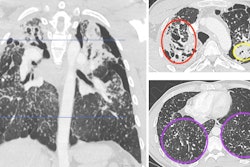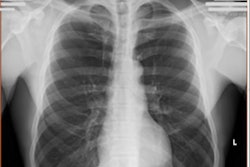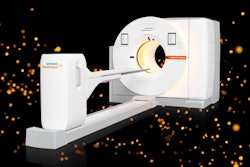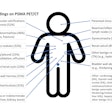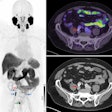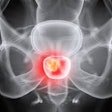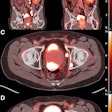PET/CT scans have revealed the metabolic activity occurring in the lungs of engineered stone workers with silicosis.
The findings in 17 former workers in Spain are among the first to illuminate the relationships between biomarkers and both cellular populations and PET/CT metabolic activity, with the aim of better understanding the mechanisms of the disease, noted corresponding author Antonio Campos-Caro, PhD, of the University of Cádiz, and colleagues.
"Engineered stone silicosis is an interstitial lung disease that progresses rapidly; in many cases, it can cause respiratory insufficiency and death. The metabolic activities occurring in the lungs and adenopathies, as well as their relationships with systemic inflammation, are unknown," the group wrote. The study was published July 14 in Scientific Reports.
Engineered stone silicosis is a serious occupational health issue, with a high number of cases being reported in countries such as Australia, Spain, Israel, and the U.S., the authors explained. The high number of cases is attributed to the emergence of new materials being used in bathrooms and kitchen countertops, they added. Moreover, the high incidence has even resulted in the prohibition of this material in Australia and proposals for its gradual ban in several European countries.
To date, most studies of silicosis have been in animal models and cell cultures. Thus, to provide new insights into the progression of the disease in afflicted patients, the researchers used F-18 FDG PET/CT scans, which capture the activity of activated inflammatory cells.
All the patients enrolled in the study had worked for at least five years finishing and installing engineered stone. The mean age of the patients was 44, and the average exposure duration was 10.9 years. The average number of years from cessation of exposure was 11.6 years.
According to the analysis, the average maximum standardized uptake value (SUVmax) of large opacities was 6.32 ± 3. All of the patients demonstrated hypermetabolic mediastinal lymphadenopathies, and 88.2% of the patients also demonstrated extrathoracic lymphadenopathies.
 Representative PET/CT images from patients with: (a) high and (b) low SUVmax values and (c) hypermetabolic lymphadenopathy in other extrathoracic areas. (a) Maximum intensity projection (MIP) PET images (bottom right) and sagittal, axial and coronal and PET/CT images of a patient with bilateral pulmonary heterogeneous condensations (white arrows) showing intense metabolic activity up to an SUVmax of 15.42 in the right upper lobe, as well as scattered millimetric nodules (black arrows). (b) MIP PET images and in the sagittal, axial and coronal PET/CT images showing bilateral pulmonary condensations, which are larger on the right side (white arrows), and numerous bilateral millimeter-sized nodules (black arrows). Slight diffuse and heterogeneous increased uptake (up to an SUVmax of 5.17) is observed, even in areas of apparently healthy lung parenchyma. (c) PET, CT, and PET/CT images in coronal and MIP sections in which, in addition to bilateral pulmonary (black arrows) and mediastinal (white arrow) involvement, multiple abdominal lymphadenopathies are observed in the celiac space, gastrohepatic ligament, and retroperitoneum (red arrows), even below the renal artery (red arrowhead).Scientific Reports
Representative PET/CT images from patients with: (a) high and (b) low SUVmax values and (c) hypermetabolic lymphadenopathy in other extrathoracic areas. (a) Maximum intensity projection (MIP) PET images (bottom right) and sagittal, axial and coronal and PET/CT images of a patient with bilateral pulmonary heterogeneous condensations (white arrows) showing intense metabolic activity up to an SUVmax of 15.42 in the right upper lobe, as well as scattered millimetric nodules (black arrows). (b) MIP PET images and in the sagittal, axial and coronal PET/CT images showing bilateral pulmonary condensations, which are larger on the right side (white arrows), and numerous bilateral millimeter-sized nodules (black arrows). Slight diffuse and heterogeneous increased uptake (up to an SUVmax of 5.17) is observed, even in areas of apparently healthy lung parenchyma. (c) PET, CT, and PET/CT images in coronal and MIP sections in which, in addition to bilateral pulmonary (black arrows) and mediastinal (white arrow) involvement, multiple abdominal lymphadenopathies are observed in the celiac space, gastrohepatic ligament, and retroperitoneum (red arrows), even below the renal artery (red arrowhead).Scientific Reports
In addition, the SUVmax of the large opacities was correlated with fibrinogen, the lymphocyte-to-monocyte ratio, the systemic inflammatory response index, and CD4+NKT cells, the researchers reported.
“One of the characteristics detected in our study involved intense metabolic activity, despite an average duration of more than 11 years since the cessation of exposure,” they wrote.
Ultimately, engineered stone silicosis is a progressive interstitial lung disease with no specific treatment except for lung transplantation, which is performed in the final stages of the disease, the group noted. To their knowledge, this is the first prospective, systematic study that described the distribution and intensity of lung lesions and lymphadenopathy in patients with the disease, they added.
“The relationships between metabolic activity and several inflammatory factors may lead to the exploration of new therapeutic targets,” the researchers concluded.
The full study is available here.






